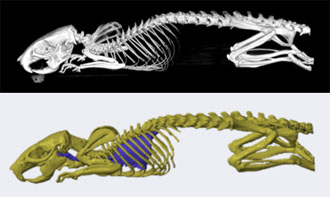Notre Dame Researchers Produce 3D Printed Skeleton

Top image shows CT scan data of a rat skeleton, and the bottom shows a 3D printed skeleton created using that data. Courtesy of Matthew Leevy/University of Notre Dame.
Latest News
April 2, 2013
As knowledge about the possibilities offered by additive manufacturing (AM) continue to trickle down through public consciousness, we keep seeing more and more uses for the technology. Like the old commercials used to say about orange juice, 3D printing isn’t just for prototyping anymore.
Researchers at Notre Dame have developed a technique using CT scans to produce 3D printed skeletons of animals, along with “pop-out” organs inside the skeletons to provide students and researchers with an up-close look at anatomy. Unlike 3D images displayed on a 2D interface, an AM created skeleton provides hands on applications without requiring dissection.
The idea for this approach came from engineering student Evan Doney. Using freeware, Doney converted data from CT scans to language that could be understood by a 3D printer. Upon receiving approval, he printed out several proof of concept skeletons, including a rabbit skull.
Plenty of companies already produce artificial skeletons, but this particular effort went a step further by including specific soft tissue objects that could be fitted inside the skeletons, creating a sort of jigsaw puzzle of whatever animal had been scanned. Organs are color coded to further enhance the educational value of the models.
Another bonus is the cost involved. While AM isn’t necessarily cheap, a small 3D printed skull (for example) that could be taken home for further study by a student costs far less than other manufactured models. Additionally, 3D printed bones could actually end up being more accurate than other models owing to the ability of printers to create more complex geometries than is standard with other methods.
A paper on the project titled “3D Printing of Preclinical X-ray Computed Tomographic Data Sets” was published at the online scientific journal Jove.
Printing bones has become quite the thing lately. Rapid Ready recently covered a story about 3D printed prosthetic skulls. Below you’ll find a video about a procedure that used the prosthetic to replace 75% of a patient’s skull.
Source: Wired
Subscribe to our FREE magazine, FREE email newsletters or both!
Latest News
About the Author
John NewmanJohn Newman is a Digital Engineering contributor who focuses on 3D printing. Contact him via DE-Editors@digitaleng.news and read his posts on Rapid Ready Technology.
Follow DE






